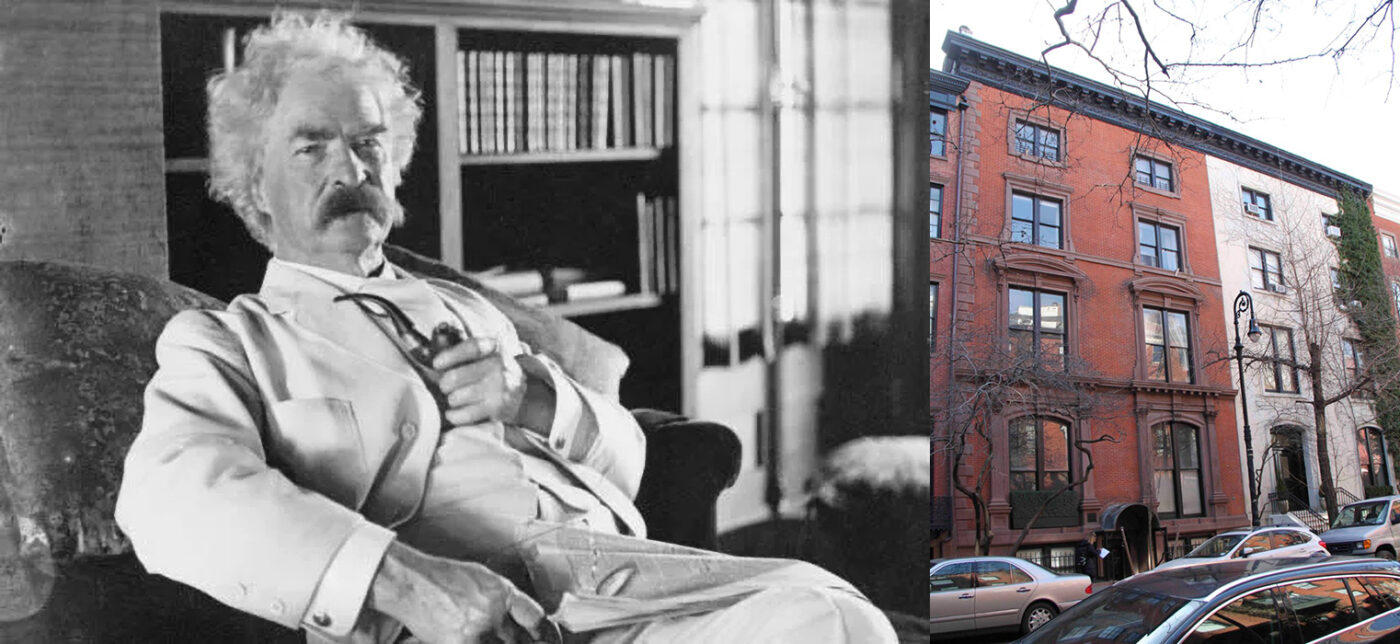The Writers of West 10th Street
Greenwich Village has long been a font of creativity, especially among those who use the written word as their medium of expression. Since the 19th century, the neighborhood has been a haven for authors and poets inspired by its architecture, cafes, proximity to fellow creators, charm, and so much more that make the Village unique. In honor of April being Greenwich Village Historic District Month (the district was designated on April 29, 1969), we’ll take a look at just a few of the famed writers who lived on just one block of the district: West 10th Street between Fifth and Sixth Avenues.
Mark Twain

Samuel Clemens (1835-1910), a.k.a. Mark Twain, was perhaps the best-known American writer, humorist, and essayist of his day. The author of such classics as The Adventures of Tom Sawyer and its sequel Adventures of Huckleberry Finn, A Connecticut Yankee in King Arthur’s Court, and Life on the Mississippi is typically remembered as a resident of Missouri or Connecticut. But in the early years of the 20th century, he called Greenwich Village his home.
In 1900 and 1901, Twain lived at 14 West 10th Street, a Greek Revival house built during the 1850s. The structure today is sometimes called the “House of Death” due to its paranormal associations: allegedly, the building is haunted by more than 20 ghosts, including Twain’s. (In 1906, the author moved to 21 Fifth Avenue, where he started work on his autobiography.)
Emma Lazarus

Two doors away and almost two decades earlier, Emma Lazarus (1849-1887) lived at 18 West 10th Street, moving here with her family in 1883. Lazarus was already a fairly well-known poet and a mentee of Ralph Waldo Emerson by the time she took up residence on the block.
That same year, writer Constance Cory Harrison asked Lazarus to write some verses for an exhibition and auction to help raise funds to complete the pedestal for the Statue of Liberty. The resulting sonnet, “The New Colossus,” reflected her concern over the fate of Jews and immigrants new to this country. She wrote of ancient lands that could keep their old traditions and “storied pomp,” as immigrants were leaving those countries to be welcomed in the United States as the “huddled masses yearning to breathe free,” even as the “wretched refuse of your teeming shore” struggled against the challenging conditions and sometimes outright discrimination they would experience here. The poem was one of her most powerful works, essentially turning the statue into a symbol of immigration and opportunity. In 1903, the sonnet was more officially connected with the Lady in the Harbor when it was inscribed on a bronze plaque within the Statue of Liberty’s pedestal.
Sinclair Lewis and Dorothy Thompson

Author Sinclair Lewis (1885-1951) and journalist Dorothy Thompson (1893-1961) lived at 37 West 10th Street starting in 1928, shortly after the couple was married. Lewis was considered one of the most important authors of his own day, penning such works as Babbitt, Arrowsmith, Elmer Gantry, and Dodsworth (which was written at least in part while Lewis lived on West 10th Street). In 1930, the last year of their residence here, Lewis became the first author from the United States to receive the Nobel Prize in Literature.
Thompson was perhaps the best-known female journalist in print and on radio in the 1930s and ’40s, recognized as the First Lady of American Journalism, equal in influence on the nation’s mindset to Eleanor Roosevelt. In August 1934, she became the first American journalist expelled from Nazi Germany.
Hart Crane

Poet Hart Crane (1899-1932) moved to New York City from Garrettsville, Ohio, when he was 17 years old. For several years, he shifted between jobs in both his new and old hometown, frequently moving from one apartment to the next. Among his Greenwich Village homes was 54 West 10th Street, where he lived starting in 1917. That year saw Crane’s first published poem, entitled “C33,” in the journal Bruno’s Weekly.
Crane’s most ambitious and rtecognized work, The Bridge, was conceived while residing elsewhere in Greenwich Village, at 45 Grove Street.
There are more writers’ lives to explore on West 10th Street and across the Greenwich Village Historic District. Start your journey with our Greenwich Village Historic District: Then & Now Photos and Tours via the “Homes and Haunts of Great Writers” entry in the map’s dropdown menu.

10th Street between Lafayette and Third was home to the Abstract Expressionist movement in painting. I live there and am a writer, sculptor and watercolorist.